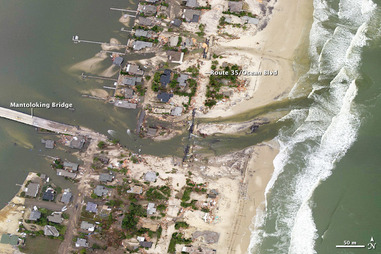-- Jersey Shore Guide & 2024 Beach Fees
|
Recreation
* Beaches * State Parks * National Parks * Waterparks * Swimming holes/Lakes * Zoos/Aquariums * Amusement parks * NJ Maps and Outdoor Places to Visit - Public Trust Doctrine and Beach Access
New Jersey's coastal beaches are subject to a legal principle, dating to ancient Rome and carried down in the common law of medieval England, of the "public trust" in which the sovereign government owns lands subject to tidal flows and that the public accordingly has the right to access the tidal waters and their shorelines. As the sovereign in its territory, the state of New Jersey owns tide-flowed (also called "riparian") lands as trustee for the public's reasonable use. Under the state Constitution, revenue from the sale or lease of tide-flowed property by the state is dedicated to support of the public schools. For much of the state's history, coastal municipalities acted with wide discretion in controlling access to beaches and setting rules for their use. A law enacted in 1955 authorized New Jersey municipalities bordering the Atlantic Ocean, tidal water bays or rivers to charge a fee to beachgoers in order to help pay for associated maintenance and safety costs. Over the last few decades however, court decisions have increasingly limited the freedom of local governments in managing access to their beaches. In 1972, the New Jersey Supreme Court held that a municipality could not charge higher fees to non-residents than to residents for use of its municipal beaches, Borough of Neptune City v. Borough of Avon-by-the-Sea, 61 N.J. 296 (1972), and a few years later also ruled that a municipality could not set aside part of a public beach for exclusive use by residents. Van Ness v. Borough of Deal, 78 N.J. 174 (1978). In 1984, the Court also extended the public trust obligation to a private association established by beachfront homeowners, concluding that it acted in a "quasi-public" capacity in attempting to restrict beach access only to association members and accordingly violated the right of the general public to gain access. Matthews v. Bay Head Improvement Association, 95 N.J. 306 (1984). More recently, legal disputes have arisen over the state's efforts to acquire through eminent domain coastal property to build dunes and other shore protection measures, particularly after the massive damage caused by tidal surges during Superstorm Sandy in October 2012. The Department of Environmental Protection is the primary state agency with jurisdiction over coastal resources under authority provided it by the federal Coastal Zone Management Act of 1970 and a series of state laws, commencing in 1914 with the Waterfront Development Law and followed by the Wetlands Act of 1970 and the Coastal Area Facility Review Act of 1973. Pursuant to its statutory authority, the DEP has issued a series of regulations, including those relating to public access, designated as its Coastal Zone Management Rules. The DEP also requires public access to the shore and tidal waterways under its Coastal Permit Program for private development and use. Despite the state's efforts to make beaches broadly accessible, some towns have discouraged use by non-residents, usually by imposing restrictions on areas, fees or hours for parking near beach access points. Following the erosion suffered by most of the state's beachfront due to Hurricane Sandy in October 2012, beaches have been restored with sand dredged and deposited by the Army Corps of Engineers. The longer-term health of the shoreline remains at risk, however, due to climate change leading to higher ocean levels. In a 2022 report, the National Oceanographic and Atmospheric Administration predicted sea-level rise of 10-12 inches along the East Coast by 2050, resulting in “moderate" flooding occurring “10 times more often than it does today..." In 2023 and 2024, several shore towns imposed restrictions and curfews on the gathering of crowds of teens and young adults after a series of episodes of boisterous behavior. * NJ beaches paid for by all, but parking keeps outsiders away, 5/21/2021, APnews.com * 10 Years After Hurricane Sandy: What’s Next for the Jersey Shore?, 6/27/2022, NJMonthly.com * Beach mob of ‘drunken teens’ forced Jersey Shore town’s crackdown, city says, 5/31/2023, NJ.com |
-- Booking.com
 Vintage Atlantic City 1920 Steel Pier Tie by NewJerseyVintage Find more Atlantic city Ties at Zazzle 
|
|
|
-- Booking.com
Many shore towns offer discounted rates for beach badges purchased prior to the summer season. The following rates are those available in summer 2024 after pre-season discounts have ended.
 Asbury Park beach. Image: NewJerseyAlmanac.com Asbury Park beach. Image: NewJerseyAlmanac.com
- A
* Asbury Park
-- See also New Jersey Day Trips - Asbury Park -- Booking.com
* Avalon
-- Avalon Beach Webcam * Avon by the Sea
-- B
 Dr. Edward H. Williams House, Beach Haven Historic District. Source: Wikimedia Commons CC BY-SA 3.0 /Jerrye & Roy Klotz, MD Dr. Edward H. Williams House, Beach Haven Historic District. Source: Wikimedia Commons CC BY-SA 3.0 /Jerrye & Roy Klotz, MD
* Beach Haven
* Bradley Beach
* Brick Township
* Largest NJ beach town in area (22 square miles) and population (just over 75,000 in 2020 Census), majority of Township area located on mainland with Ocean Beaches I, II, and III situated on Barnegat Peninsula, barrier peninsula separating Barnegat Bay from Atlantic Ocean, with mainland and beach area not geographically adjacent. Incorporated as a township in 1850, from portions of both Dover Township (now Toms River Township) and Howell Township. Named after Joseph Brick, owner of Bergen Iron Works located on Metedeconk River. Three public swimming beaches located off Route 35, no swimming at Windward Beach on Princeton Avenue, but amenities include playgrounds, volleyball nets, restrooms, fishing and crabbing piers, bocce courts, horseshoe pits, picnic tables and a gazebo. * Brigantine
* Located on Brigantine Island just north of Atlantic City, only land access by NJ Route 87 (locally known as Brigantine Boulevard) over Justice Vincent S. Haneman Memorial Bridge . Borders Atlantic County municipalities of Atlantic City and Galloway Township (from which it was created as separate municipality in 1890). Name derived from nearby shipwrecks of a type of sailing vessel known as a "brigantine" with wo-masts and fully square-rigged foremast and at least two sails on main mast: a square topsail and a gaff sail mainsail. Site of Brigantine Lighthouse built 1926 in effort to promote island as location for potential residents and visitors; Marine Mammal Stranding Center, state's only marine stranding center, rehabilitates and releases stranded marine mammals and sea turtles, rescuing more than 3,900 whales, dolphins, seals and sea turtles since establishment; part of Edwin B. Forsythe National Wildlife Refuge on northern end of Brigantine Island, habitat for endangered or threatened birds, including bald eagle, peregrine falcon, American black duck, and piping plover. Beach patrol gives swimming lessons each summer, also water safety, skin cancer avoidance lectures to groups and schools, also operates two-week ‘junior lifeguard” program for up to 125 candidates to learn basic lifeguarding techniques and water safety. -- Brigantine Beach Webcam - see also Historic Sites - Lighthouses -- C -- Booking.com
* Cape May Point State Park
* State park of 244 acres of freshwater meadows, ponds, forests, dunes and beach, short bike ride from town of Cape May, free to public, location for birding, picnics, and nature walks with ponds, coastal dunes, marshes, and forest habitat, home to endangered birds. Cape May Point State Park also site of 157-foot Cape May Lighthouse still active aid to navigation. Free on-site parking. Cape May Point beaches run from the State Park (Lighthouse Avenue) up to and including the Alexander Avenue Jetty, but swimming restrictions due to underwater hazards, but surf fishing permitted. - see also State Parks - see also Historic Sites - Lighthouses -- D * Deal
|
|
-- G
-- H
-- I * Island Beach State Park, Seaside Park
* Narrow barrier island stretches for 10 miles between Atlantic Ocean and Barnegat Bay. One of best NJ remaining coastal habitats comprising dunes, maritime plants, treshwater wetlands, maritime forest and tidal marshes with state's largest osprey colony, as well as peregrine falcons, wading birds, shorebirds, waterfowl and migrating songbirds. Swimming permitted only during summer when lifeguards on duty. Popularity often leads to early closing of access gate during weekends, other peak periods when parking lots reach capacity. - see also State Parks -- K
* Keansburg
-- L * Lavallette
* Ocean County borough with 2020 US census population of 1,787 situated on Barnegat Peninsula, barrier peninsula separating Barnegat Bay from Atlantic Ocean. Incorporated as borough in 1887 from portions of Dover Township (now Toms River Township), named for Elie A. F. La Vallette, one of first US Navy rear admirals appointed when President Abraham Lincoln created rank in 1862, and father of Albert T. Lavallette, co-founder of borough. Nine protected ocean beaches designated for swimming as well as two on Barnegat Bay. Four of ocean beaches have specifically designated areas for surfing and surf-fishing. Adult daily fee of $13 tied for NJ highest with Jenkinson's beach in Point Pleasant Beach. * Loch Arbour
* Small village in Monmouth County with population of 224 in 2020 Census, third-smallest municipality in NJ, only two blocks long from north to south and only one tenth of a square mile in area. Created 1957 as separate municipality from portion of Ocean Township after residents organized to oppose potential approval of condominium development, named after Lochaber, Scotland. Bordered to north by Borough of Deal and Borough of Allenhurst, to west by Borough of Interlaken and to south by City of Asbury Park and Deal Lake. * Long Beach Township

* Long Branch; Seven Presidents Oceanfront Park
-- Continued Manasquan thru Wildwoods |













